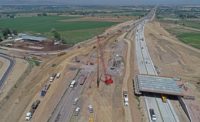ENR Southwest's 2012 Owner of the Year: Nevada Dept. of Transportation








Collaborative Partner
Department efficiency has improved through private sector partnering, which recently resulted in the implementation of electronic bidding. Online submittals decrease unintentional calculation errors while reducing agency staff time, paperwork and other manual procedures by 70%. NDOT has since fully embraced partnering. In fact, the agency requires that projects over $10 million use mandatory partnering procedures to quickly resolve issues before they impact cost or completion.
"NDOT has a very collaborative project approach," says Sean Stewart, executive vice president of the Nevada Contractors Association, a Las Vegas-based nonprofit trade group. "They're willing to work with contractors in order to do what is best for the project."
Collaboration was needed to complete the historic $240-million Hoover Dam Bridge, which opened in late 2010. The 1,960-ft-long, 88-ft-wide single-arch structure's future was threatened by slow reauthorization of a new federal transportation bill, which held up the final $90 million piece of funding. In 2004, however, NDOT and its Arizona counterpart each pledged $50 million in GARVEE (Grant Anticipation Revenue Vehicle) bonds to keep construction moving.
"NDOT is open to thinking outside the box and trying unfamiliar things for the benefit of a project," says Paddy Murphy, Southwest region manager of Aggregate Industries, North Las Vegas. "Their partnering mentality has helped fast-track construction, reduce change orders and minimize disputes."
Bridging the Future
Partnering has proven invaluable to the department's $600-million, 8.5-mile extension of I-580 through Pleasant Valley between Reno and Carson City. It's the largest, most ambitious state transportation project yet. The job includes building the nation's longest cathedral arch bridge—a 1,722-ft-long, 295-ft-tall span over Galena Creek.
Bridge construction has proved tricky, however. A previous contractor exited the job, leaving work only partly complete. Fisher Sand & Gravel Co., Dickinson, N.D., subsequently was hired to finish the job. Department engineers specified a pilot truss erection method, but Fisher came up with an alternative to briefly elevate the creek floor and build a temporary bridge arch. The 1-580 extension is scheduled to be completed this summer.
"It's not often you get to work with a contractor for five years. We share the same office," Brad Durski, NDOT resident engineer, says of the Fisher Sand & Gravel team. "This is the epitome of a partnering job."
NDOT expanded its partnering reach by obtaining legislative approval to use construction management at-risk as a project delivery method. The department hopes to have up to a half dozen construction manager at-risk projects under way within the next six months.
"We need to explore every possible opportunity to maximize our resources," says Martinovich, who is a certified civil engineer in Nevada and California. "Investments in our state's future can't be made without partnering. It's not fair to put all the risk on the contractors; we're in this together."





